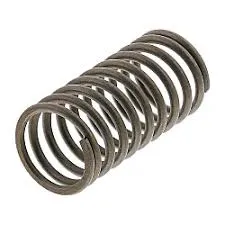
- Mobile Phone
- +8613931874955
- sales@cntcmetal.com
extension helical spring
Understanding Extension Helical Springs Principles and Applications
Helical springs are mechanical devices that are widely used across various industries for their ability to store and release energy. Among the various types of helical springs, extension helical springs stand out due to their unique design and functionality. This article explores the principles behind extension helical springs, their applications, and the factors influencing their performance.
Principles of Extension Helical Springs
At the core of extension helical springs is the principle of elasticity. These springs are typically made from coiled wire forming a helix shape, designed to stretch when a tensile force is applied. The fundamental characteristic of a helical spring is its ability to revert to its original shape upon the release of this force, embodying Hooke's Law, which states that the force exerted by a spring is directly proportional to its extension. Mathematically, this is expressed as \( F = k \cdot x \), where \( F \) is the force exerted, \( k \) is the spring constant, and \( x \) is the extension or elongation of the spring.
Design Features
The design of extension helical springs plays a crucial role in their performance. Several factors are considered when designing these springs
1. Wire Diameter Thicker wires yield stronger springs but may limit flexibility. Conversely, thinner wires offer greater extension but lower resistance.
2. Coil Diameter The diameter of the coils affects both the spring's compression and its flexibility. A larger diameter allows for more significant extension at a given load.
3. Number of Coils The total number of coils influences how much the spring can stretch. More coils generally lead to lower spring rates, allowing for more extensive displacements under load.
4. Material Selection The choice of material impacts both the strength and elasticity of the spring. Common materials include stainless steel, music wire, and oil-tempered wire, each offering different characteristics suited to specific applications.
Applications of Extension Helical Springs
Extension helical springs are utilized in various applications due to their versatility and effectiveness. Here are some common uses
extension helical spring

1. Automotive Industry These springs are often found in suspension systems, acting as dampers and providing improved ride quality by absorbing shocks and vibrations during travel.
2. Mechanical Devices In machinery, extension springs are used to maintain tension on belts or chains, ensuring smoother operation and prolonging the equipment's lifespan.
3. Consumer Products Everyday items, such as window shades, retractable measuring tapes, and toys, frequently employ extension springs to facilitate movement or enhance functionality.
4. Aerospace and Aviation Within the aerospace industry, these springs are important for balance and control in various aircraft components, providing the necessary tension for smooth operation.
Performance Factors
The performance of extension helical springs is influenced by various external factors, including
1. Load Conditions The nature of the load applied (static or dynamic) greatly affects the spring's behavior. Dynamic loads, such as those influenced by vibrations or movements, can lead to changes in the spring's performance over time.
2. Environmental Conditions Factors such as temperature, humidity, and exposure to chemicals can degrade spring performance. Choosing the right material and coating can extend the lifespan of the spring in challenging environments.
3. Fatigue Resistance Over time and with repeated usage, extension springs can suffer from fatigue, leading to loss of elasticity. Designing springs with a high fatigue resistance is imperative, especially in applications where they will experience a significant number of cycles.
Conclusion
Extension helical springs are vital components in numerous mechanical systems, owing to their ability to absorb energy, provide resistance, and return to their original shape. Their design intricacies, coupled with the principles of elasticity, render them indispensable in modern engineering and everyday applications. Understanding their fundamental properties and performance factors can lead to better design choices, efficient use of materials, and enhanced durability in various applications. As technology advances, the innovations in materials and design methodologies will likely evolve the functionalities and applications of extension helical springs even further, solidifying their integral role in mechanical solutions across industries.
share:
-
Why Sacrificial Formwork Is Redefining Underground ConstructionNewsJun.06,2025
-
The Structural Dynamics of Modern Concrete: How Snake Spacers Revolutionize Flexible ReinforcementNewsJun.06,2025
-
Snake Spacers Smart-Lock Concrete Reinforcement with Surgical PrecisionNewsJun.06,2025
-
Snake Spacers: Reinforcement Precision for Modern Concrete ProjectsNewsJun.06,2025
-
Snake Spacers Powering Concrete's Structural DNANewsJun.06,2025
-
Slither into Success: Snake Spacers' Precision Bite for Unbreakable ReinforcementNewsJun.06,2025
-
Sacrificial Formwork: Building Stronger, Faster, and Safer StructuresNewsJun.06,2025



















